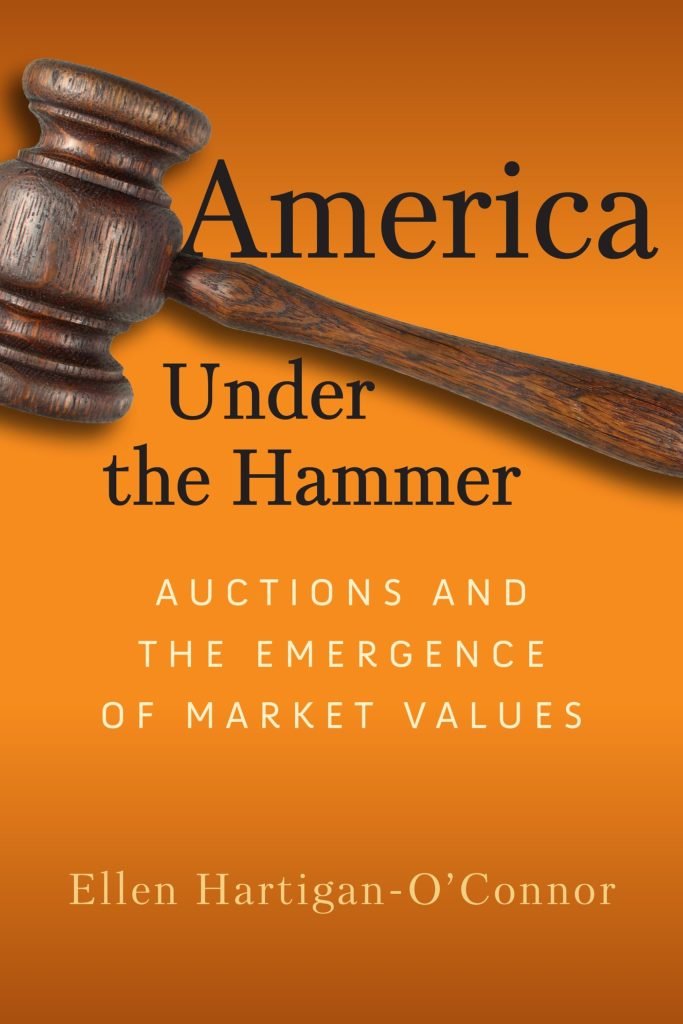

Ellen Hartigan-O’Connor is Professor of History and Associate Dean for Graduate Students and Postdoctoral Scholars at the University of California, Davis. This interview is based on her new book, America Under the Hammer: Auctions and the Emergence of Market Values (University of Pennsylvania Press, 2024).
JF: What led you to write America Under the Hammer?
EH: I was in the archives researching my first book, The Ties that Buy: Women and Commerce in Revolutionary America, when I came across a Ietter from a wealthy Charlestonian to her daughter. She had just been to a preview showing for an estate auction, and in the letter she launched into a commentary on the goods at the preview, the prices she thought they would get at sale, and how surprised she was to see some new silverware that she had no idea the dead woman had ever owned—and she knew a lot about the woman’s tableware. I realized that she was describing a consumer experience I knew nothing about. More importantly, I realized that my assumptions about consumers and consumer culture were framed around what happened in shops, but here in front of me was a different world of used goods and dynamic pricing that women as well as men participated in. Further, the letter was an example of economic culture that scholars had missed by focusing on published advertisements and political satire. I wrote America Under the Hammer to widen our sense of who was an economic participant in the past and who was an economic thinker. Auctions were everywhere in the eighteenth and early nineteenth centuries, and their rules and dynamics set the expectations for what Americans took for granted about economic sources of value by the end of the nineteenth century.
JF: In 2 sentences, what is the argument of America Under the Hammer?
EH: The history of early American auctions reveals that the commercial practices developed within colonial power structures established the taken-for-granted social relations recognizable as nineteenth-century American capitalism. Auctions connected financial, social, and symbolic uses of exchange to enshrine an understanding of value linked to price and competition as the best signal of economic fairness.
JF: Why do we need to read America Under the Hammer?
EH: It is common to talk about “the market” acting as a disembodied force of nature, but an auction was populated by real people—bidders, buyers, sellers, witnesses, commodified humans—whose behavior reflected social relationships and cultural assumptions. The price called out when the auctioneer’s hammer came down was a product of those people, those relationships, and those cultures, plus the rules of the game established by colonial and then state and US governments. Auctions therefore offer an ideal window on the experiments of valuing in the early years of American capitalism and give us deeper appreciation for how our economy and its rules were established.
Also, anyone who is interested in the political uses of economic institutions will benefit from spending time with early American auctions. Auctions were tools of settler colonialism, mechanisms for raising the claims of creditors over debtors, community rituals of punishing political rivals, and ruthless assertions of racial hierarchy. The shocking notion that a person could be sold in the same way as a chair fundamentally shaped the modern capitalist idea that everything has its price and that price is the measure of value.
JF: Why and when did you become an American historian?
EH: I took a seminar my last year in college on women in colonial America that centered historical imagination as an essential research skill. Archival evidence about women—enslaved and free, of all backgrounds—can be fragmentary, non-existent, or narrated through powerful unreliable reporters. What do we do with these silences and heavily mediated information? I love the challenge of bringing curiosity to sources, noticing patterns of behavior and analyzing the logic behind specific forms or expressions. The work of interpreting a diverse past is meticulous and patient, but also creative. Plus, there are always many surprises—like the man who, to make money to pay his debts, held an auction from within his Boston jail cell!
JF: What is your next project?
EH: I am collaborating with my UC Davis colleague Lisa Materson on a project about women and Revolution in the Americas. Revolutions shaped the borders of belonging in the new United States across the late eighteenth and nineteenth centuries. Our project follows the lives of women navigating exile, emancipation, and citizenship, demonstrating how borders were organized around race and gender as well as political sovereignty.
JF: Thanks, Ellen!
Such a small world. I work at UC Davis and have interacted with Ellen frequently–but had NO idea what she had written about as an historian. Reading this took me back to my upbringing in Lancaster County, PA–a place where auctions are still thriving. As memories flooded back, I realized the important social and economic role auctions played in the communities of that County. We had (and they still have) real estate, animal, produce, and quilt auctions (for non-profit fundraising). Fascinating.